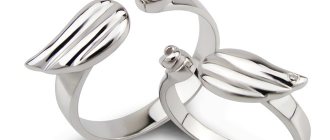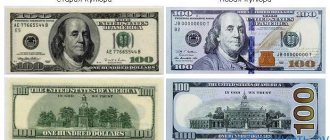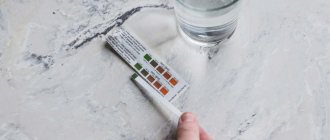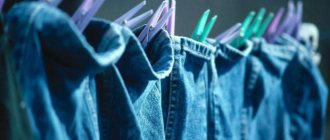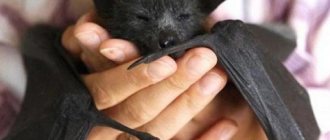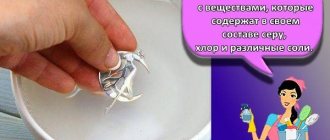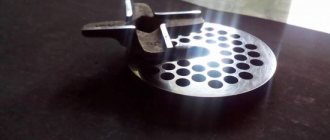If you have purchased a piece of diamond jewelry and doubt that it is real, or are just planning to purchase it, it will not hurt to know how authenticity is checked. Affordable home tests will dispel or confirm suspicions and reduce the likelihood that under the guise and price of a diamond you will be sold a sparkling cheap fake.
What does a real diamond look like?
The most popular, prestigious, expensive and promoted stone is the diamond. Every woman (and some men) dreams of him. The natural raw material for making diamonds is diamonds. They are mined from deposits.
Such crystals have an inconspicuous appearance and irregular configuration. For an ignorant person, this is an inconspicuous stone that does not at all resemble a luxurious sparkling diamond.
A diamond is made of pure carbon, but sometimes it contains impurities of other substances that were around while it was in the ground. The fewer foreign inclusions found in a diamond, the higher its purity. Samples without large inclusions, defects, or cracks are sent to jewelers for processing. To become a full-fledged diamond, the diamond must weigh at least 0.29 carats.
The content of other chemical elements gives diamonds their color. Today, pink, yellow, and blue diamonds are in fashion, but colorless specimens are most valued.
After the jeweler cuts, grinds and polishes the diamond, it becomes a luxurious diamond with the following properties:
- Unsurpassed hardness. The diamond can withstand pressure of several tons. It cannot be scratched. Only another diamond can leave a mark on it. Its hardness is 10/10 on the Moss scale (for gold this figure is 3/10).
- Fragility. "A Girl's Best Friend" doesn't pull any punches. If you hit a diamond hard with a hammer, the stone will crack just like glass.
- High refractive index. When light hits a diamond, the stone flashes with myriads of silvery sparks. Due to strong refraction, the diamond does not shimmer with multi-colored highlights, but scatters a noble glow consisting of shades of gray.
- Dispersion or “play of the stone”. According to this indicator, the diamond is a recognized record holder. No other gemstone produces such intense shine.
- Luminescence. In ultraviolet light, the diamond glows with a soft blue glow.
- Resistant to acids (except hydrofluoric acid).
- Withstands high temperatures. The stone will burn if heated to 850 °C or higher.
- Does not change color or fade. And in a hundred years it will shimmer and shine.
Information about the main qualities of a diamond will help you independently distinguish a diamond from a semi-precious stone if you cannot check it with a jeweler.
Real diamonds look like this:
- Faceted stone. If it is unframed, it is accompanied by a certificate confirming its authenticity and quality. If the stone is inserted into the product, then the name (br), clarity (evaluated by four parameters, most often it is 2/4), carat (for example: 1 ct), cut type (cr - round, o - oval) is written on the tag and so on).
- Shimmers and shines. In the light, the stone sparkles with all its facets. This is its distinctive property, which is reflected in the name. Translated from French, “brilliant” means brilliant.
- Has an invisible cut. If it is inserted into a piece of jewelry, it is impossible to see its top and cut angles.
- Sparkles in shades of grey.
- Does not wobble, securely fixed in the product.
- Set in gold or platinum.
- Doesn't shine through. In a properly cut diamond, the bottom is not visible.
- There must be a hole under the stone. The lower part of the diamond (pavilion) should not come into close contact with the metal, because refraction is determined by the stone-air parameter, not the stone-metal parameter.
- Store-bought diamonds often have a round shape and a classic cut of 57 facets.
A black diamond is expensive, but looks less impressive.
It does not play in the light, but only gives an aristocratic glow from the dark surface.
Photos of the most beautiful diamonds in the world
Despite their impeccable beauty, diamonds of special quality have a bloody trail through centuries of history. Alas, the legends have only softened over a long time and have survived to this day in a relatively acceptable form. Of course, the 21st century has finally completed the list of terrible crimes associated with diamonds, and today stones are exhibited, sold at auctions and passed on by inheritance without the frightening crime, as was the case historically. But there are also diamonds that are crystal clear before fate and the law; we give three such examples below.
Please note that even the most famous, highest quality diamonds still have inclusions, albeit tiny ones: these defects are the direct, simple and most honest proof of the authenticity of the gemstones.
Diamond Cullinan
– its two aristocratic parts belong to the sweetest lady from Great Britain, or rather the entire English court. And the complete Cullinan family includes 9 large diamonds and about a hundred small ones. The original diamond measured 11 x 5 x 6 cm and weighed more than 600 grams (3106 carats).
| Cullinan I 530 carat | Cullinan II 317 carats |
Excelsior
– held the title of the largest diamond until the birth of Kulinan. The original weight of the Excelsior diamond was 995 carats, and after cutting, 21 beautiful diamonds were seen, and all of them quickly went to private collections and fashionable jewelry houses.
| The largest of the Excelsiors | Heidi Klum, Excelsior advertising | Diamond before cutting |
Centenary
- closes the top three and at the same time is the most mysterious, albeit infinitely beautiful diamond in the world. 274 carats were cut by professionals from De Beers, and the stone owes its origin to the same mine in South Africa where Cullinan was found. Today Centenary is not exhibited and, moreover, it is unknown where this marvelous diamond, insured for a record amount of $100 million, is located.
The cost of such diamonds is incalculable, and it is unlikely that at least one of them will ever be sold again. The price of 2.5 million dollars for one of these stones is very modest, and a diamond presented by Heidi Klum as a swimsuit decoration was sold for $11 million.
In our store, diamonds are presented, of course, not in such a stellar format, but the authenticity and quality of the stones indicated in the characteristics certainly does not raise doubts or questions.
The catalog of diamond products includes various jewelry and accessories; we are sure that here you can find a gift for yourself or a loved one. All diamond products come with an expert opinion, and when purchasing online there is an additional 5% discount.
What can it be easily confused with?
A diamond in a piece can be replaced not only at the jewelry manufacturing stage, but also in a jewelry salon. Counterfeits have been used for a long time; they existed back in 1920. In the past, they tried to pass off radiant or corundite as a diamond. Later, other cheap imitators of the “royal stone” appeared - strontium, rutile, titanium, white sapphire.
Modern technologies have made it possible to create artificial stones that are absolutely identical in appearance to processed diamonds. They are made of such high quality that even testers are not always able to recognize a glass diamond.
The properties of a gemstone are best imitated by the following fakes:
- Cubic zirconia (zircon) is a synthetic stone, zirconium dioxide. It was invented by Soviet physicists in the 70s of the last century. Since then, products with cubic zirconia have been sold all over the world. Zircon shines almost as brightly as a diamond, but with iridescent highlights. It can be transparent (the most expensive) and colored. Currently, cubic zirconia is produced in six main colors.
- Moissanite is carborundum, the most accurate artificial copy of a diamond. It is 90% similar to the precious “prototype”. Its shine is even more intense than that of the “king of stones”. It is impossible to identify moissanite by eye; even an experienced jeweler can make a mistake. Not all testers are up to this task.
- Rock crystal is similar in appearance to a diamond, and after cutting it acquires a dazzling shine. You can recognize an imitation by the following characteristics: rock crystal is set in silver, less often - in gold, a diamond is set only in platinum and gold. Glue is often used to fix crystal, but this is not done when working with diamonds.
The following are also sold under the guise of a processed diamond:
- white topaz;
- yttrium aluminum garnet;
- leucosapphire;
- white beryl;
- artificial diamond;
- transparent spinel;
- rhinestones (ornamental stones made of glass);
- combinations of synthesized stones.
What stones are they trying to pass off as diamonds?
We would like to make a reservation right away: in the world of jewelry there are legal analogues of diamonds and this does not mean that the stones are fake. Cubic zirconia artificially created in the USSR and lesser-known moissanites are to one degree or another similar to diamonds, and conscientious sellers always indicate the characteristics of the stones in the certificate. There is plenty of information about cubic zirconia, as well as the stones themselves, but moissanites, from the group of natural carbides, are extremely rare in their natural form and cost a lot, so their synthetic analogues are more common.
| Moissanite improved | Moissanite synthetic | cubic zirconia | Diamond |
In addition to cubic zirconia and moissanites of any origin, under the best conditions, colorless topaz or leucosapphire (a colorless stone of the corundum group) can be roughly similar to diamonds. Attempts to pass off rock crystal as a diamond were also encountered in the non-professional jewelry world, but the properties of this stone are so far from the appearance of a cut diamond that the seller’s cunning was exposed in the first seconds after the display of the mineral or jewelry with it.
| Leucosapphire | Colorless topaz | Rhinestone |
Sapphire and topaz clearly show the natural heavenly shade characteristic of these stones in their natural color - shades of blue, light blue. And if in diamonds the reflections of this spectrum are also well expressed, then in corundum and topaz the color penetrates the entire stone, and does not remain only on the edges. Rock crystal does not have even a third of the light refraction properties that are observed in any diamond, even not of the highest quality.
Professional authentication methods
A purchased diamond can be checked for authenticity (for a fee) by a jeweler in a workshop or salon that sells items made of precious metals. For express analysis, a diamond detector is used. The check takes 8-10 minutes.
Outdated models of such devices only examine the thermal conductivity of the mineral, and therefore do not always provide reliable information about the authenticity of the stone. This tester will not help identify moissanite because it has the same thermal conductivity as a diamond.
Professional jewelers who specialize in working with diamonds use an advanced diamond authentication tester. He studies the refraction of light. In this indicator, moissanite is ahead of diamond, which makes it possible to immediately detect a fake diamond.
The diamond tester only tests cut crystals.
Such a device will not be able to examine a rough diamond and determine its authenticity.
The most accurate result is guaranteed by the use of three sensors that analyze reflectance, luminescence and photoluminescence. Inexpensive diamond testers give a 50/50 result - “either a diamond or not.” Such devices cannot be trusted.
Experienced jewelers are able to identify a diamond without the use of technology. To distinguish a diamond from a semi-precious imitation or glass, they examine the stone using the following criteria.
Light
Diamonds have special optical properties that are easy to detect by visual inspection in the light or using a magnifying glass with 10x magnification:
- They give the same intense shine not only from above, but from all sides.
- In directed light they scatter with silvery reflections.
- Opaque. Light falling on a smooth surface of a stone is reflected from the edges.
If you look at the stone from above, you will see many iridescences and a tiny dot in the middle - a thorn. There is a simple way to check this property: draw a letter on a piece of paper and try to see it through the mineral. If it's a diamond, you won't see anything.
Comparison
To distinguish a genuine diamond from other stones, it is enough to know a few basic differences:
- A real diamond is a natural formation; it is never absolutely pure. Looking at it through a magnifying glass, you will definitely see the smallest imperfections in it. If the stone has a perfectly smooth and even surface, you have an artificial analogue.
- A cut diamond sparkles and shimmers so much that other stones appear inexpressive and faded against its background. However, it is difficult to distinguish a stone by this indicator. Some artificially synthesized minerals (moissanite) can sparkle no worse than diamonds.
- Diamond is a record holder for strength; after processing, its edges become sharp and clear. In glass imitators they are less sharp and somewhat rounded.
Distortion
A natural diamond does not exhibit double refraction. If you shine light on it and look through a magnifying glass, you will notice that a direct light beam is reflected from its edges. It never splits in two or deviates to the side. If it turns out that one face reflects two rays (flat and inclined), it is cubic zirconia.
Weight
A reliable method that jewelers have long used to assess the authenticity of diamonds is weighing on a carat scale. It is based on the fact that the size of the stone must correspond to the carat weight. It is known that zircons are half as heavy as diamonds, so a fake will be immediately detected.
The weight of precious stones is expressed in carats: 1 ct = 0.2 g. For example: small diamond: 2.0 mm = 0.029 ct; medium: 3.0 mm = 0.098 ct, 5 mm = 0.450 ct; large: 6.5 mm = 1.010 ct, giant at 9 mm = 2.59 ct.
Frame
A diamond is an elite stone, so jewelers are very meticulous about setting it in a product. Depending on the frame, it appears larger or smaller. The frame allows you to hide minor defects and foreign inclusions. Metal, setting and setting are factors that will help distinguish a real cut diamond from a budget fake.
When purchasing diamond jewelry, check it for compliance with the following rules:
- High purity diamonds are usually set in platinum or white gold. It is believed that white metal does not distract attention from the luxurious stone, but only highlights the brilliance and luxury.
- Colored diamonds are set in red or yellow gold. It harmoniously combines with fantasy stone.
- Silver frames are not elite enough and expensive. Cut diamonds are inserted only into jewelry made of precious metals - gold and platinum.
- A diamond is set in one of three ways. A popular type of fastening is using tiny metal claws (prongs). Blind fastening is a reliable method of encrusting products with diamonds, but it visually reduces the size of the mineral. Much less common is corner setting, when the stone is inserted not into a prepared socket, but into the metal plate itself. Other fastening methods are also used, but the underside of the stone is always left open. If the stone is fastened carelessly (loose, too recessed into the frame, the distances between adjacent paws are not the same) - it is not real. Diamonds are not treated this way.
- No adhesive setting is used for natural stones. Artificial crystals are “planted” on the glue.
To make sure the stone is set in platinum or white gold and not silver, check the hallmark of the metal.
Ultraviolet
A more accurate method that will distinguish a diamond or a cut diamond from inexpensive counterparts of artificial origin is based on the use of ultraviolet light. If you have a quartz medical or ultraviolet lamp at home (for drying gel polish), shine it on the stone and evaluate the result:
- Under ultraviolet light, diamonds emit a bluish glow.
- If the stone does not react to exposure to UV rays, it is glass or another imitation diamond.
- The appearance of a green, gray or yellow glow indicates moissanite.
Diamonds have another specific feature - they are invisible in X-rays. But this property cannot be tested at home.
Professional tests for diamond recognition
If, when conducting home tests, it is not clear whether the diamond is real or fake, then you can resort to various types of professional tests. Jewelers have special equipment, as well as tools that will help distinguish the original from the fake.
It is possible to determine the authenticity of a stone using tests such as high-sensitivity scale weights, heat, and powerful microscopes. However, the most reliable test is ultraviolet light. A real diamond has a bluish light when exposed to ultraviolet light. The deeper the blue color, the greater the value of the stone and the purer it is.
Found a violation? Report content
How to distinguish a diamond from a fake at home
To independently verify the authenticity of a stone, you can use several proven home methods, some of which are also applicable in a jewelry salon.
To get an accurate result, arm yourself with a flashlight and sandpaper. Prepare a magnifying glass with at least 10x magnification. You will need a piece of soft, clean and dry cloth, water and vegetable oil.
It is better to carry out a home examination on a sunny day.
Water
Using water, you can instantly find out whether or not a diamond is set in a ring, earrings or other purchased jewelry. Sprinkle a couple of drops of water onto the top flat surface of the stone. Poke them with a needle. If the drops have not changed, then you were not deceived. On the surface of artificial stones they will disintegrate into small fractions.
To get a more visual picture, take vegetable oil rather than water, put it in a pipette and drop it onto the stone. If the drop remains intact, this will prove the authenticity of the mineral; if it splits into parts, this is a negative sign. They sold you a fake under the guise of a diamond.
Breath
Natural diamonds do not become covered with “perspiration” even at high humidity. Knowing this feature, you can instantly check the stone not only at home, but also in the store before purchasing the product.
To do this, wipe the crystal with a soft flannel cloth and then breathe on it for 2-3 seconds. If it remains dry and shiny, it is a diamond. The fake will fog up, become damp and dull.
Price
Cost is an essential parameter for evaluating a diamond.
Diamonds are the most expensive gemstones. They can't be cheap.
If you are offered an inexpensive diamond ring (at a discount), do not give in to such temptation, otherwise you will invest your money in a worthless thing.
The price of a diamond is calculated from such indicators as the type and quality of cut, carat weight, clarity, color rarity, and current prices on the world market. The cost of such stones directly depends on the size. A 1-carat diamond costs 15-20 times more than a scattering of tiny diamonds with the same total weight.
Scratches
Diamond is a super-strong mineral. It is impossible to scratch it. To ensure that a piece of jewelry is a real diamond, rub the surface of the stone with sandpaper or corundum. If there are no traces left, this is truly the “king of stones.” If roughness or scratches appear on the surface, this is just a skillfully executed fake.
Use this method very carefully to avoid scratching the gold setting of the jewelry. Do not test the hardness of a stone using another diamond; it will easily damage its “brother.”
Prohibited Methods
If you don’t mind ruining a stone imitation of a cut diamond, then you can determine the authenticity of a diamond using cruel methods:
- Keep the stone in the flame of an open fire for 3-4 seconds. If it stays the same, it's a diamond. Moissanite will change color to green, and the original color will not be restored. It will be hopelessly spoiled.
- Drop the crystal into hydrochloric acid. If it is a linden tree, white streaks will form on it. It will no longer be possible to remove these marks. A real diamond will not suffer at all from such testing.
- If you suspect zirconium, lightly run a diamond pencil over the stone. This tool will leave a distinct mark on the semi-precious stone.
When performing this test, do not apply excessive force, otherwise the stone will crack.
The authenticity of a diamond can only be determined using such barbaric methods at home, after it has already been purchased. In a jewelry salon, no one will allow you to throw it into acid or burn it in fire. These testing methods are not suitable for set stones (due to the risk of damaging the jewellery).
Basic properties of the stone
After cutting, grinding and polishing, the diamond turns into a luxurious diamond. A real stone has the following properties:
- High degree of hardness. The gem is capable of withstanding pressure of several tons. It cannot be scratched. Only another diamond can leave a mark on a stone. The hardness parameters of the product are 10/10 in accordance with the Mohs scale.
- Fragility. This gem does not tolerate high shock loads. If you hit a diamond with a hammer, it will break like glass.
- High refractive parameters. When light hits a diamond, it sparkles with many silvery sparkles. Strong refraction prevents it from shimmering with colored highlights. It rather glows nobly in gray tones.
- Dispersion. This mineral has the most pronounced shine.
- Luminescence. When exposed to ultraviolet light, the crystal acquires a soft blue glow.
- Resistance to acids. The exception is fluorescent.
- Resistance to elevated temperatures. The stone can only burn when heated to 850 degrees.
- Color stability. Even after 100 years, a real stone will shine.
Authentication Tips
Some more useful information for those who decide to test a rough diamond on their own:
- You can verify the authenticity of the purchased stone in this way: lubricate its surface with vegetable fat and glue it to a window or other glass surface. A real diamond will not fall off, but an artificial one will immediately fall down. The described method is applicable only to unmounted minerals. If the diamond is in a ring or earrings, it will not stay on the glass and will fall under the weight of the metal.
- There is a common myth among people that a high-quality natural diamond is invisible in water. It is not true. No matter how transparent a diamond is, it will still be visible because its density is higher than that of water. But the dive test is still not useless. By lowering the stone into a glass of water, you can check its integrity. If it is glued together from two stones, then the border of the joint will be visible.
- A magnet will help you distinguish a synthetic diamond from a natural one. 90% of artificial crystals are attracted to it.
Only an independent gemologist can accurately distinguish a real diamond from a cheap synthetic fake and support his conclusions with a certificate. This examination is carried out in a special gemological laboratory. If we are talking about a stone weighing 1 carat or more, then it is better not to take risks and turn to professionals.
Modern imitation diamonds copy diamonds so accurately that an ordinary person without special training and expensive equipment will never detect a fake. There are different ways to find out whether a stone actually is an expensive diamond or an ordinary piece of glass, but most of these methods do not provide a 100% guarantee.
Fog test
This is one of the simplest and most economical tests. In addition, it is quite reliable. To find out if a diamond is real, you need to place it directly in front of your mouth and breathe on the mineral to create a kind of mist.
If the fog remains on the stone for more than two seconds, this indicates that it is not a real diamond. Real diamonds instantly dissipate heat from breathing and therefore virtually no fog forms on them, much less it will not last long.
To see the difference, you need to try this experiment on real and fake stones.
What is cubic zirconia?
This is an artificial and relatively cheap material, very similar to a gemstone in appearance, but differing in properties. Its production is a rather difficult and painstaking process, but it cannot be compared in complexity to high-quality cutting of a diamond.
The price per gram of good cubic zirconia reaches $5.
The artificial mineral received its name from the Physical Institute of the Lebedev Academy of Sciences (FIAN). It was there that it was synthesized by a team of Soviet scientists in the 1970s. It is noteworthy that the goal of the project was to obtain a substance with special optical properties suitable for creating laser equipment.
Artificial stone has several names. Chemists know it as zirconium dioxide. In the West, it is more often called zirconite, jewellite or daimonstone.
The invention of Soviet scientists caused a real sensation among both fashionistas and jewelers. Compared to a diamond, this stone was worth pennies. In 1990, 50,000,000 carats of cubic zirconia were produced, and this is an astronomical amount. Every year the pace of production is accelerating, and more and more synthetic gems are entering the markets.
Methods that should not be used
When answering the question of how to distinguish a diamond, one cannot fail to mention prohibited methods. They can only be used if you don’t mind damaging the fake:
- Hold the pebble over an open fire for a few seconds. If it retains its properties, it is a real diamond. In this case, the moissanite will take on a green tint. However, it will not be possible to restore the original color. He will be hopelessly damaged.
- Immerse the crystal in hydrochloric acid. White streaks will appear on the fake. It will not be possible to remove such traces. A natural diamond will not suffer from such actions.
- If you suspect zirconium, you can run a diamond pencil over the stone. Under the influence of the tool, a clear line will appear on the semi-precious stone. When performing such checks, you should not use too much force, as there is a risk of cracks.
A few more ways
Are there other ways? How to evaluate a diamond ourselves if we do not want to remove the diamond from the jewelry? There is a thermal method. However, it does not give one hundred percent confidence in the stone, but it certainly gives food for thought.
If a gem heats up and remains warm for a few more minutes, it’s just cubic zirconia. In a similar way, you can conduct a steam test, i.e. wipe the object with a cloth and breathe on it. If steam remains on the surface, it is cubic zirconia.
You can also take a closer look at the gem. If we see any grains of sand in it, this can prove that the diamond is genuine. This is not the case with artificial stones because they were created in sterile conditions.
If after all these tests we have doubts, it is better to contact a specialist and dispel them forever.
Differences between moissanite and diamond
Let's consider another analogue of the “king of stones”, moissanite. It is silicon carbide and has the formula SiC.
Natural moissanite was first discovered at the end of the last century in Arizona. Its discoverer was the French chemist Ferdinand Moissan, who christened the new mineral with his own name.
As it turns out, there is very little natural moissanite on Earth: it is found mainly in the remains of meteorites. As a rule, there are small pebbles that do not have a diamond shine and transparency. The largest nuggets found did not exceed a few millimeters in diameter.
Almost at the same time, Edward Atcherson patented a technology for the synthesis of powdered SiC, which was used primarily in the production of abrasives. It was a synthetic carborundum material, chemically a complete analogue of moissanite.
The invention of the technology for synthesizing jewelry-quality carborundum produced a real revolution. Jewelers received an almost complete analogue of a diamond, which is more than an order of magnitude cheaper than its noble counterpart. However, even synthetic moissanite is much more expensive than cubic zirconia.
Natural moissanite is negligible. So don’t trust sellers: you won’t find jewelry with this naturally occurring mineral. But carborundum is a permanent resident of jewelry store shelves.
It is almost impossible to distinguish moissanite from a diamond at home, at least not for a specialist. All methods that can be applied without the use of special equipment lead to damage to moissanite or require the presence of a natural diamond as a sample.
You can recognize a diamond next to a moissanite by its more subdued shine: the second shines brighter due to its higher refractive index. Moissanite is equally transparent, very refractory, and resistant to aggressive chemicals. Its hardness ranges around 9 on the Mohs scale. This means that it can be scratched with a diamond, but not with anything else.
Gold earrings with diamonds (go to the SUNLIGHT catalogue)
If you don't mind the stone, you can perform a basic thermal test. Apply the flame of a match or lighter to the diamond and moissanite. Both stones will become smoky, but if the diamond appears in its original form after cleaning the carbon deposits, the carborundum will turn green and become cloudy.
How do diamonds appear?
Diamonds are a symbol of durability, femininity, luxury and, of course, love. However, they begin their story as nuggets of coal hidden deep underground. Here, under the influence of enormous pressure and high temperatures, an unusual crystallization process begins, which often lasts millions of years. This is how diamond is formed - one of the hardest materials found naturally on our planet.
Under the influence of tectonic processes, diamonds slowly move to the surface of the earth, where people mine them. At this stage, the rough diamond does not look like the magically shimmering jewel we know. It has the form of larger or smaller crystals, usually with eight, less often six, not very smooth rounded edges. At this stage, the action of the forces of nature ends, and the work of specialists, polishing artists, begins.
Checking diamonds with special devices in the laboratory
Laboratory analysis of a diamond is not a cheap procedure; it is carried out in specialized institutions and requires professional equipment and several full-time employees. As a rule, the examination consists of several steps:
- Weigh a piece of jewelry or stone individually to the nearest 0.0005 carat.
- Material identification using a thermal conductivity measuring device.
- Visual inspection through an electron microscope.
- Placement in the spectrometer and recording the results.
- Assessment of cut quality based on comparison with reference samples.
- Color check under lighting conditions of different temperatures.
- Fluorescent test under a long-wave ultraviolet lamp.
- Control assessment of mineral purity using a microscope.
Based on the manipulations performed, the laboratory employee draws up a written conclusion that confirms or denies the authenticity of the diamond. In addition, all physical parameters are prescribed in it - from mass and size to refractive index. Such a document has legal force to resolve any conflict situations through the court.
A moment of history
Diamond mining is a very difficult and very profitable business. Everyone knows about the gold rush, but few know that there was also a diamond rush. At the end of the 19th century, rich diamond deposits were discovered in Africa. The news quickly spread across the Old and New Worlds, and prospectors of all stripes flocked to South Africa. Subsequently, the city of Kimberley was founded there.
Miners of the past believed that diamonds formed in river beds. The truth turned out to be different: in fact, 90% of diamonds are mined in kimberlite pipes - natural wells of volcanic origin. These formations were named after that African settlement. They look like this:
Diamonds are found on all continents except Antarctica. In addition to Africa, large deposits of the valuable mineral are located in Russia, Australia and Canada.
The value of diamonds is partly due to the complexity of their processing. It is believed that diamond is an incredibly hard material that can cut glass and metal. This is true. However, the other side of the coin is increased fragility. The mineral is almost impossible to scratch, but relatively easy to break. Because of this, they did not dare to process it for a very long time, and only in the 15th century did the Indians offer an effective technology for making diamonds.
The word “diamond” itself translated from French means “shining, bright, brilliant.” This perfectly reflects the main thing in the appearance of the stone and the very thing for which beauty connoisseurs love it.
Basic characteristics of a diamond
The price of a gemstone is determined by its quality. It consists of four main criteria:
- Carat.
- Features of the cut.
- Color.
- Purity of the stone.
Let's take a closer look at each of them.
Carat
To make it easier to measure precious stones and pearls, a non-systemic unit of mass was introduced - the carat. It is equal to 200 milligrams.
The heavier the stone, the more expensive it is.
The largest diamond found weighed an incredible 3,106 carats. The price of one carat of a good quality diamond is approximately 750,000 rubles. Remember what we said about the price of a gram of cubic zirconia...
How to determine in a ring?
You can check a fake by eye in a ring or in earrings by looking at the markings. Natural stone is always framed with precious metals, which are marked with special stamps.
It is recommended to look for the 14K, 750, 900 signs on gold products, and PT and Plat on platinum products. Another way is to look closely at the stone.
To achieve shine and play of light, the diamond is placed in an open frame; this method of mounting allows you to see the lower edges of the diamond.
A sign of a fake is the mirror coating of the lower edges.
